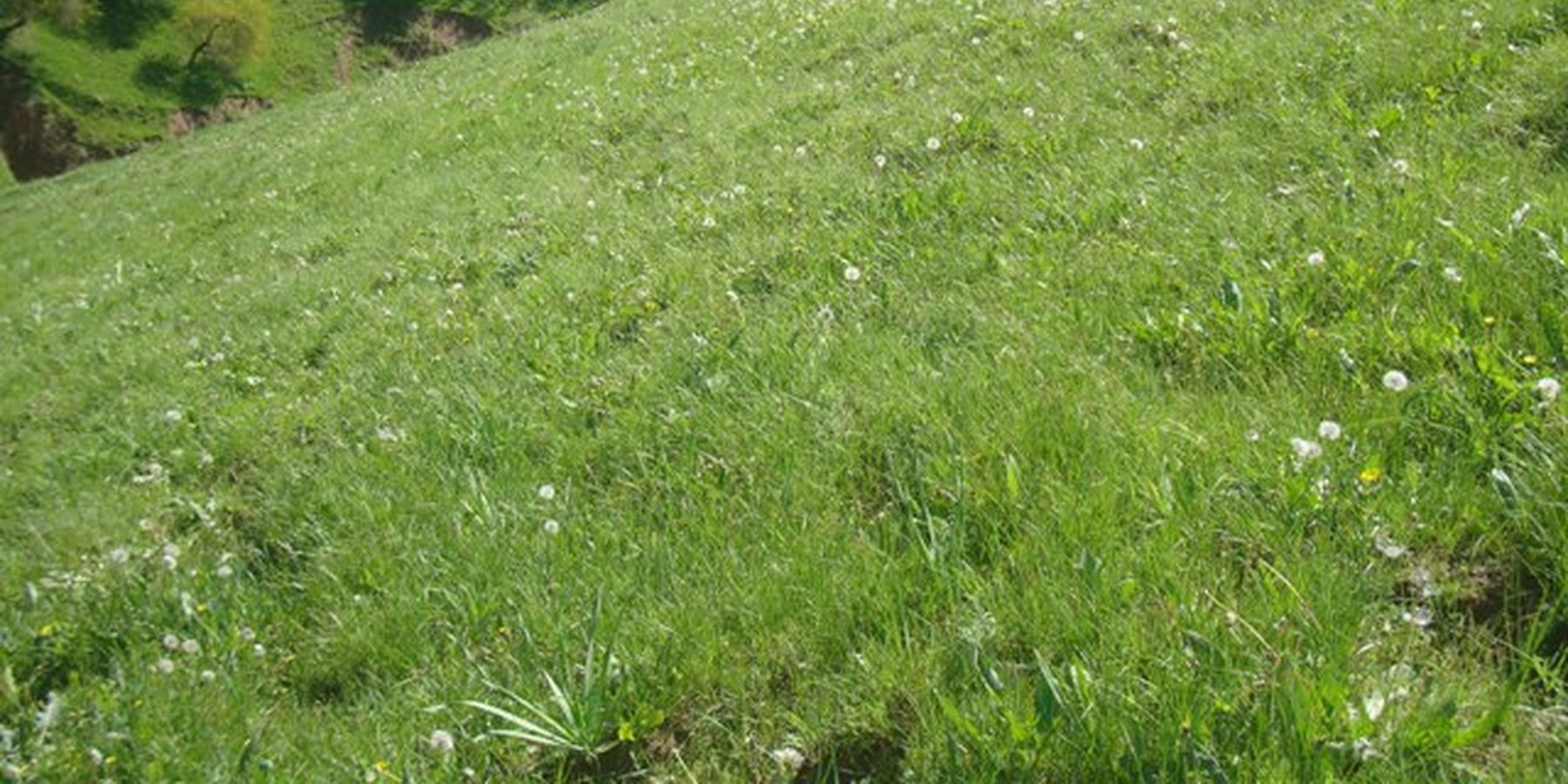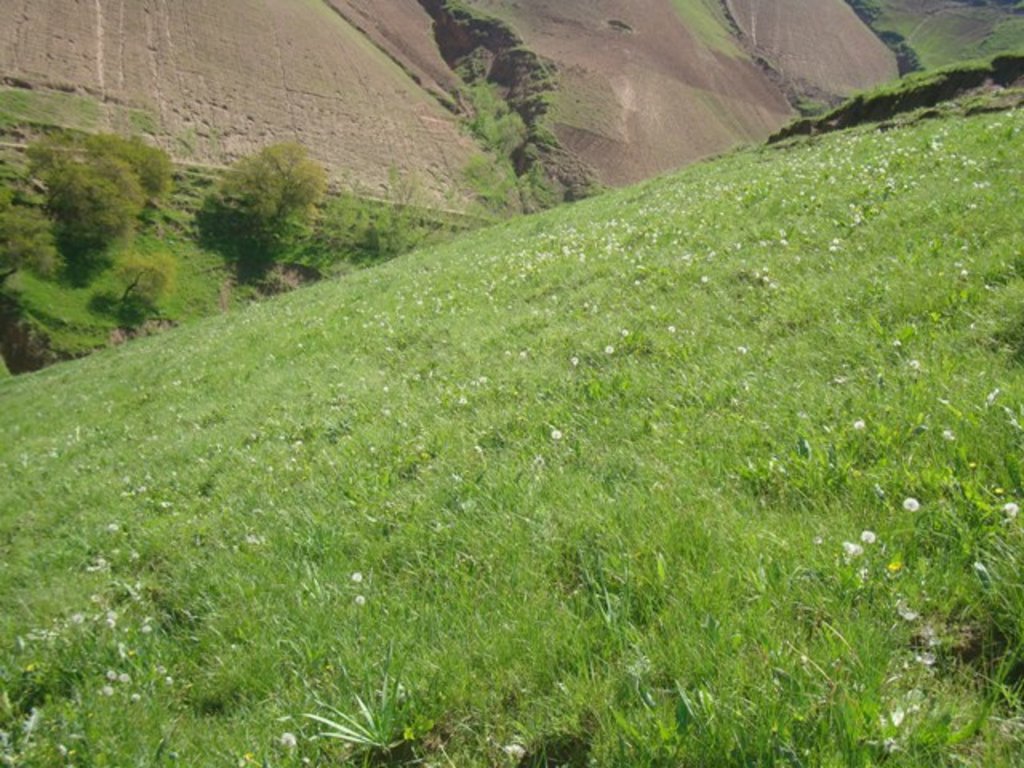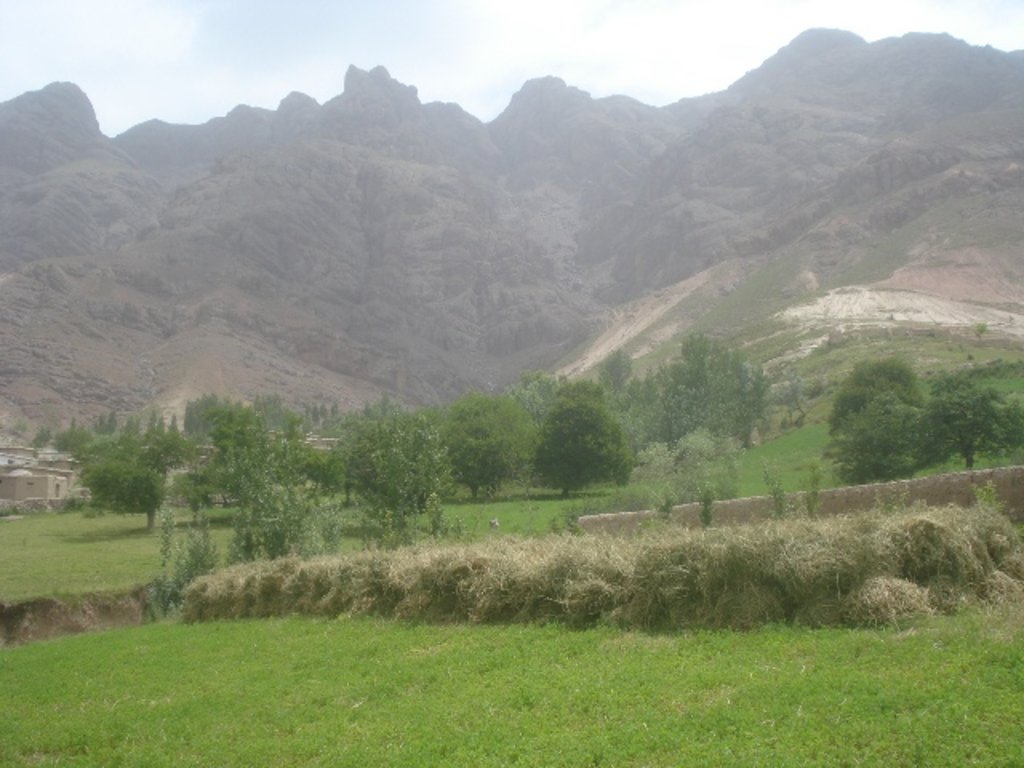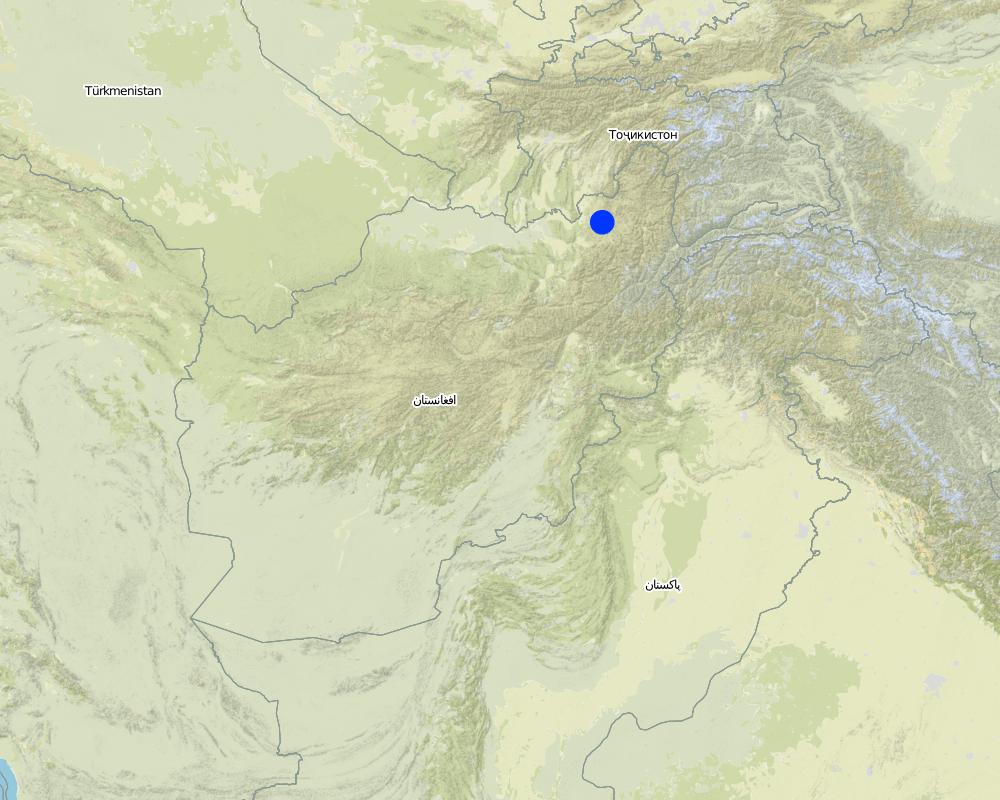Rehabilitation of degraded pastures with alfalfa [Афганистан]
- Создание:
- Обновить:
- Составитель: Bettina Wolfgramm
- Редактор: Roziya Kirgizbekova
- Рецензенты: Rima Mekdaschi Studer, Alexandra Gavilano
Ehyoye charogoh bo posheedani tukhmi reshqa
technologies_672 - Афганистан
Просмотреть разделы
Развернуть все Свернуть все1. Общая информация
1.2 Контактные данные специалистов и организаций, участвующих в описании и оценке Технологии
Специалист по УЗП:
Researcher:
Название проекта, содействовавшего документированию/оценке Технологии (если применимо)
Livelihood Improvement Project Takhar, Afghanistan (LIPT)Название проекта, содействовавшего документированию/оценке Технологии (если применимо)
Potential and limitations for improved natural resource management (NRM) in mountain communities in the Rustaq district, Afghanistan (Rustaq NRM Study)Название организации (-ий), содействовавших документированию/оценке Технологии (если применимо)
Terre des Hommes (Terre des Hommes) - ШвейцарияНазвание организации (-ий), содействовавших документированию/оценке Технологии (если применимо)
Swiss Agency for Development and Cooperation (DEZA / COSUDE / DDC / SDC) - ШвейцарияНазвание организации (-ий), содействовавших документированию/оценке Технологии (если применимо)
Bern University of Applied Sciences, School of Agricultural, Forest and Food Sciences (HAFL) - ШвейцарияНазвание организации (-ий), содействовавших документированию/оценке Технологии (если применимо)
CDE Centre for Development and Environment (CDE Centre for Development and Environment) - Швейцария1.3 Условия, регламентирующие использование данных, собранных ВОКАТ
Составитель и ответственный(-ые) специалист(-ы) согласны с условиями, регламентирующими использование собранных ВОКАТ данных:
Да
1.4 Декларация по устойчивости описываемой Технологии
Вызывает ли описанная здесь Технология проблемы деградации земель настолько, что ее нельзя назвать природосберегающей?
Нет
Пояснения:
SLM practices documented in the frame of the Rustaq NRM study were established only recently (1-3 years ago). It is too early for a final judgment on the sustainability of these technologies within the human and natural environment of Chokar watershed.
1.5 Ссылка на Анкету (ы) по Подходам УЗП (документируется с использованием ВОКАТ)
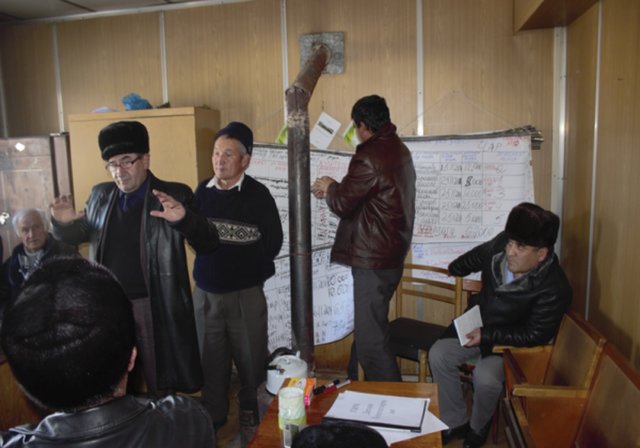
Pasture and Livestock Management Plan [Таджикистан]
"Pasture and Livestock Management Plan" is a participatory approach which is guiding pasture users, members of Pasture User Unions and Pasture User Groups to develop their action plan on pasture and livestock management. The approach brings together stakeholders, who are involved at any stage in pasture management or can contribute …
- Составитель: Askarsho Zevarshoev
2. Описание Технологии УЗП
2.1 Краткое описание Технологии
Определение Технологии:
Degraded pastures are restored with alfalfa through broad seeding method. The area is put under quarantine for three years to allow for the pasture to restore sufficiently.
2.2 Подробное описание Технологии
Описание:
Project supported pasture rehabilitation has taken place in the villages Sari Joy, Jawaz Khana and Dashti Mirzai, located in Chokar watershed of Rustaq District in Northern Afghanistan. The Chokar watershed is a mountainous area situated between 600 - 2,500 m above sea level. The climate is semi-arid with harsh and cold weather in winter and hot and dry summers. The annual precipitation in average years is 580mm. Land degradation affects all forms of land use and includes low vegetation cover, heavy top soil erosion from water, and poor soil fertility. Unsustainable agricultural practices, over-exploitation and high pressure on the natural resources are adversely impacting on the socio-economic well-being of local communities as well as contributing to the risk for being adversely affected by drought as well as landslides and flash foods triggered by heavy rainfall. The data used for the documentation of the technology is based on field research conducted in Chokar watershed, namely in the villages: Sari Joy, Jawaz Khana and Dashti Mirzai. These villages represent the upper, the middle and the lower zone of Chokar watershed, respectively. They differ considerably in access to services and infrastructure, but in general are poorly served. The communities depend on land resources for sustaining their livelihoods. In a good year with high yields, wheat-self-sufficiency lasts about 5 months. The three villages are home to ethnic Qarluq communities. Since 2012 the Livelihood Improvement Project Takhar (LIPT) implemented by Terre des hommes (Tdh) Switzerland has initiated a range of NRM interventions.
Livestock keeping is one of the key livelihood strategies in rural Rustaq in addition to cultivation of cereals. Families rely on their livestock not only for consumption of meat from cows, goat and sheep, dairy products such as milk and sour milk, but also as means of transportation (donkeys), labour force in agriculture (oxen, donkey) and source of cash income. Every family strives to increase their household’s livestock as much as they can, which increases the pressure on the local pastures leading to extensive overgrazing. The pastures in Jawaz Khana, Dashti Mirzai and Sari Joy are characterized by poor vegetation cover, low carrying capacity and sever erosion with deep rills clearly visible on the surface. These severely degraded pastures continue to be used uncontrollably without any management schemes or regulations in place. Cropland not suitable for cultivation has been converted to pastures. The quantity and quality of livestock fodder is insufficient for all the livestock affecting poor animal health.
The village communities have recognized the poor condition of their pastures and the need to take measures to revert the situation. Pasture rehabilitation measures were introduced, which aim to restore heavily degraded pasture land with alfalfa. Initially the land user and the community agrees to leave the sown pasture under quarantine for three years. The restoration measures include: leveling the soil with a rack to soften the soil and prepare the seedbed. 3,5 kg of alfalfa is seeded on 1 jerib or 0.2 ha of pasture land using the broadcast seeding method. Fertilizer application (DAP and/or animal manure) is followed by the seeding. The area is protected from grazing during three years. During this quarantine period the alfalfa has to grow in sufficient size in order to be harvested for livestock fodder.
It has been observed that after two years in some part it is already possible to harvest the alfalfa. Improvements of the pasture are visible given the fast growth rate of the alfalfa crop. The plant grows well without irrigation, which is favorable given the shortage of irrigation water in the villages. The rehabilitated pastures will slow down the run-off, improve water infiltration and protect the pasture from erosion during heavy rain fall. The land users recognize the pasture improvements and relatively increased fodder availability. Alfalfa reseeding is done in 5-10 years and appeals to the needs of the land users, which cannot afford annual reseeding. One of the constraint remains is the quarantine period of 1-3 years, which deprives the livestock from fodder and the farmers have to find options for covering the loss.
Women are generally aware about the use of alfalfa for the production of better fodder for their livestock. Women do take part in haymaking, collecting the hay and bringing it to their homes or to the community fodder bank. Often they are helped by their children to do the work.
2.3 Фотографии, иллюстрирующие Технологию
2.5 Страна/ регион/ места, где применяется Технология, информация о которых собрана в данной Анкете
Страна:
Афганистан
Административная единица (Район/Область):
Takhar Province, Rustaq District
Более точная привязка места:
Sari Joy, Jawaz Khana, Dashti Mirzai villages
Охарактеризуйте пространственное распространение Технологии :
- равномерно-однородное применение на определенной площади
Если точная область неизвестна, укажите приблизительную площадь:
- < 0,1 км2 (10 га)
Пояснения:
This documentation is based on the experiences of SLM implementers from Sari Joy (7 treated plots), Jawaz Khana, (5 treated plots), and Dashti Mirzai (3 treated plots). Additionally insights were gained through interviews with both SLM implementers and observers from all three villages.
Map
×2.6 Сколько лет применяется данная Технология
Если год начала применения Технологии достоверно неизвестен, дайте примерную оценку:
- менее 10 лет назад (недавняя)
2.7 Внедрение Технологии
Укажите, как именно Технология УЗП была внедрена:
- через проекты/ внешнее вмешательство
Пояснения (тип проекта и т.д.):
Livelihood Improvement Project Takhar (LIPT) supported by Swiss Development Cooperation (SDC) from 2012-17
3. Классификация Технологии УЗП
3.1 Основные цели и задачи реализации Технологии
- повышение производства
- снижение или предотвращение деградации земель, восстановление нарушенных земель
3.2 Текущий(-ие) тип(-ы) землепользования на территории, где применяется Технология

Пастбищные угодья
Экстенсивный выпас:
- Полукочевое скотоводство
Интенсивный выпас/ выращивание кормов:
- Стойловое содержание/ нулевой выпас
Вид животных:
- козы
- овца
- cows
Пояснения:
Number of growing seasons per year: 1
3.3 Изменилось ли использование земель в связи с внедрением Технологии?
Изменилось ли использование земель в связи с внедрением Технологии?
- Да (Пожалуйста, заполните нижеприведенные вопросы относительно использования земель до внедрения Технологии)

Пахотные угодья и плантации
Пояснения:
Some plots of the pastures are previous croplands, which have been strongly degraded and no longer used for crop cultivation.
3.4 Водоснабжение
Обеспеченность водой участков, где реализуется Технология :
- сочетание богарных и орошаемых земель
3.5 Категория УЗП, к которой относится Технология
- прекращение хозяйственного использования (прекращение доступа к территории, поддержка восстановления)
- Улучшение почвенного/ растительного покрова
3.6 Мероприятия УЗП, выполняемые в рамках Технологии

Мероприятия с использованием растительности
- Р2: Злаковые и многолетние травянистые растения

управленческие мероприятия
- У1: Смена типа землепользования
- У2: Изменение формы/ интенсивности хозяйствования
3.7 Основные проблемы деградации земель, на решение которых направлена Технология

водная эрозия почв
- ВЭп: поверхностная эрозия/смыв верхних почвенных горизонтов

ветровая эрозия почв
- Эп: утрата плодородного слоя почвы

ухудшение физических свойств почв
- Фу: уплотнение

биологическая деградация
- Бр: сокращение растительного покрова
- Бк: сокращение количества биомассы

деградация водных ресурсов
- Ва: почвенная засуха
3.8 Предотвращение и снижение деградации земель, или восстановление нарушенных земель
Укажите цель Технологии по отношению к деградации земель :
- снижение деградации земель
- восстановление/ реабилитация нарушенных земель
4. Технические характеристики, мероприятия по практической реализации, вложения и стоимость
4.1 Технический рисунок, иллюстрирующий Технологию
Спецификация (пояснения к техническому рисунку):
The degraded land is selected for rehabilitation. The preparation of seedbed consists of leveling the soil with a rack to make it even and soften the topsoil. Alfalfa seed is sown through broadcast seeding method. The amount of seeds for 0.2 ha of land is 3.5 kg of alfalfa seeds. Fertilizer is applied during the seeding. The pastures are rainfed in general, but those area which have higher water availability, irrigate their plots during dry season. The seeded pasture is closed for quarantine for three years and the livestock is not allowed in the area. There is no fence around the pasture.
Автор:
Roziya Kirgizbekova
Дата:
05/06/2017
4.2 Общая информация по необходимым вложениям и стоимости
Уточните, как рассчитывались затраты и вложения:
- на площадь, где применяется Технология
Укажите размер и единицу площади:
1 ha
Укажите денежные единицы, использованные для подсчета затрат:
- Доллары США
Если это необходимо, укажите обменный курс от доллара США к местной валюте (например, 1 доллар США = 79,9 бразильского реала): 1 доллар США =:
67,0
Укажите среднюю дневную заработную плату наемных работников:
5.2-5.3 USD
4.3 Мероприятия, необходимые для начала реализации
| Деятельность | Время (сессия) | |
|---|---|---|
| 1. | Selection of the land for rehabilitation | Fall |
| 2. | Leveling the land with a rake | Fall |
| 3. | Sowing alfalfa (broadcast seeding) | Spring |
| 4. | Site under quarantine | Three years |
| 5. | Site protection | Three years |
4.4 Вложения и затраты, необходимые для начала реализации
| Опишите затраты | Единица | Количество | Затраты на единицу | Общая стоимость на единицу | % затрат, оплаченных землепользователями | |
|---|---|---|---|---|---|---|
| Оплата труда | Leveling the land | person-day | 100,0 | 5,3 | 530,0 | 100,0 |
| Оплата труда | Sowing alfalfa | person-day | 5,0 | 5,3 | 26,5 | 100,0 |
| Оплата труда | Site protection | year | 1,0 | 447,0 | 447,0 | 100,0 |
| Оборудование | Shovel | piece | 1,0 | 3,8 | 3,8 | 100,0 |
| Оборудование | Rope | meter | 50,0 | 0,07 | 3,5 | 100,0 |
| Оборудование | Rake | piece | 1,0 | 3,0 | 3,0 | |
| Посадочный материал | Alfalfa seed | 17,5 | 0,42 | 7,35 | ||
| Удобрения и ядохимикаты | DAP | kg | 125,0 | 0,9 | 112,5 | |
| Удобрения и ядохимикаты | Urea | Kg | 125,0 | 0,45 | 56,25 | 100,0 |
| Общая стоимость запуска Технологии | 1189,9 | |||||
| Общие затраты на создание Технологии в долларах США | 17,76 | |||||
Если землепользователем оплачено менее 100% затрат, укажите, кем покрывались остальные затраты:
Livelihood Improvement Project Takhar (LIPT) implemented by Terre des hommes (Tdh) Switzerland
Пояснения:
Costs calculated for a Technology area of 1ha was only done for the purpose of the WOCAT documentation. In reality SLM plots are on average 0.2-0.4 ha or 1-2 jeribs. Costs were simply multiplied by 5. The actual costs for a 1ha plot might be slightly different.
4.5 Поддержание/ текущее обслуживание
| Деятельность | Сроки/ повторяемость проведения | |
|---|---|---|
| 1. | Hay making | Summer |
| 2. | Delivery of hay to the fodder bank | Fall |
| 3. | Protection of the pasture during quarantine | Three years |
4.6 Стоимость поддержания/ текущего обслуживания ( в год)
| Опишите затраты | Единица | Количество | Затраты на единицу | Общая стоимость на единицу | % затрат, оплаченных землепользователями | |
|---|---|---|---|---|---|---|
| Оплата труда | Hay making | person day | 35,0 | 5,3 | 185,5 | 100,0 |
| Оплата труда | Delivery of the hay to the fodder bank | person day | 35,0 | 5,3 | 185,5 | 100,0 |
| Оплата труда | Protection during quarantine | year | 2,0 | 447,0 | 894,0 | 100,0 |
| Оборудование | Sickle | piece | 1,0 | 2,25 | 2,25 | 100,0 |
| Оборудование | Pitchfork | piece | 1,0 | 5,3 | 5,3 | 100,0 |
| Общая стоимость поддержания Технологии | 1272,55 | |||||
| Общие затраты на поддержание Технологии в долларах США | 18,99 | |||||
Пояснения:
Costs calculated for a Technology area of 1ha was only done for the purpose of the WOCAT documentation. In reality SLM plots are on average 0.2-0.4 ha or 1-2 jeribs. Costs were simply multiplied by 5. The actual costs for a 1ha plot might be slightly different.
4.7 Наиболее значимые факторы, влияющие на стоимость затрат
Опишите наиболее значимые факторы, влияющие на стоимость затрат:
Due to the remoteness of the villages where the technology has been implemented, all the inputs for establishment, such as agricultural equipment, plant material, fertilizers, etc., are purchased in Rustaq town. The expenses for traveling and delivering the inputs affect the establishment costs.
5. Природные и социально-экономические условия
5.1 Климат
Среднегодовое количество осадков
- < 250 мм
- 251-500 мм
- 501-750 мм
- 751-1000 мм
- 1001-1500 мм
- 1501-2000 мм
- 2001-3000 мм
- 3001-4000 мм
- > 4000 мм
Укажите среднегодовое количество осадков (если известно), мм:
580,00
Пояснения/ комментарии по осадкам:
Average annual percipitation for the area was calculated with 580 mm, with minimums in dry years (2000 and 2001) of 270 mm and maximums in wet years (2009/2010) of 830 mm. The absolut maximum rainfall was calculated for 1986 with 1024 mm. The data series covers the time from 1979 to 2014.
Укажите название соответствующей метеостанции:
Climate Forecast System Reanalysis (CFSR), http://rda.ucar.edu/pub/cfsr.html
Агроклиматическая зона
- полузасушливая
Derived from the publicly available dataset on length of growing period (LGP) (Fischer 2009 / IIASA-FAO). Internet link: http://tiles.arcgis.com/tiles/P8Cok4qAP1sTVE59/arcgis/rest/services/Length_of_growing_period/MapServer
5.2 Рельеф
Склоны (преобладающие):
- пологие (0-2%)
- покатые (3-5%)
- покато-крутые (6-10%)
- крутые (11-15%)
- очень крутые (16-30%)
- чрезвычайно крутые (31-60%)
- обрывистые (>60%)
Формы рельефа:
- плато/ равнины
- гребни хребтов/холмов
- склоны гор
- склоны холмов
- подножья
- днища долин
Зона высотной поясности:
- 0-100 м над уровнем моря
- 101-500 м н.у.м.
- 501-1000 м н.у.м.
- 1001-1500 м н.у.м.
- 1501-2000 м н.у.м.
- 2001-2500 м н.у.м.
- 2501-3000 м н.у.м.
- 3001-4000 м н.у.м.
- > 4 тыс. м н.у.м.
5.3 Почвы
Средняя мощность почв:
- поверхностные (0-20 см)
- неглубокие (21-50 см)
- умеренно глубокие (51-80 см)
- глубокие (81-120 см)
- очень глубокие (> 120 см)
Гранулометрический состав (верхнего горизонта):
- средние фракции (суглинистый, супесчаный)
Гранулометрический состав (на глубине более 20 см):
- средние фракции (суглинистый, супесчаный)
Содержание органического вещества в верхнем горизонте:
- среднее (1-3%)
- низкое (< 1%)
Если возможно, приложите полное описание почв или укажите доступную информацию, например тип почв, рH/ кислотность почв, ёмкость катионного обмена, содержание азота, содержание солей и т.д.
Local land users differentiate between the following soil types where the technology is implemented:
- Light soils: moderately deep; texture of topsoil medium (loamy, silty); low topsoil organic matter
- Dark soils: moderately deep; texture of topsoil medium (loamy, silty); medium topsoil organic matter
5.4 Доступность и качество воды
Уровень грунтовых вод:
5-50 м
Доступность поверхностных вод:
средняя
Качество воды (без обработки):
питьевая вода хорошего качества
Является ли солёность воды проблемой?
Нет
Происходят ли периодические затопления территории?
Да
Регулярность:
эпизодически
Комментарии и дополнительная информация по качеству и количеству воды:
Floods occur mainly during the rainy seasons in spring and autumn. Availability of surface water differs for the three study villages Sari Joy, Jawaz Khana, and Dashti Mirzai. Sari Joy has sources and good surface water availability. Jawaz Khana has poor water availability as water has to be fetched from a lower laying stream. Dashti Mirzai has good water availability also from an irrigation channel.
5.5 Биоразнообразие
Видовое разнообразие:
- низкое
Разнообразие местообитаний:
- низкое
5.6 Характеристика землепользователей, применяющих Технологию
Осёдлый или кочевой:
- Осёдлый
Рыночная ориентация производства:
- натуральное хозяйство (самообеспечение)
Доходы из других источников:
- 10-50% всех доходов
- > 50% всех доходов
Относительный уровень достатка:
- плохой
Индивидуальное или коллективное хозяйство:
- частное/ домовладение
Уровень механизации:
- ручной труд
Пол:
- женщины
- мужчины
Возраст землепользователей:
- средний возраст
- пожилой
Укажите другие важные характеристики землепользователей:
The land users in the area where the Technology is applied belong to the Uzbek ethnic minority group Qarluq.
Although the men are generally the main land users, however, women and children also take active part in the related work. The functions of men and women are clearly distinguished within the Afghan society. At the same time within the family this division of work and functions also results in men and women working hand-in-hand. An improvement of the family’s livelihood situation is expected to positively affect all family members. While, it is recognized that the involvement of women is key in order to secure basic human rights for everyone, to achieve good governance, sustainable development, and to efficiently contribute to poverty reduction (SDC 2004), it is also clear that a context sensitive approach is of high importance.
Women in rural Afghanistan are involved in many production and income generating activities that contribute to the overall household income, however, very few women own resources such as land and livestock, and their income generating options are fewer in comparison to that of men.
5.7 Средняя площадь земель, используемых землепользователями с применением Технологии
- < 0,5 га
- 0,5-1 га
- 1-2 га
- 2-5 га
- 5-15 га
- 15-50 га
- 50-100 га
- 100-500 га
- 500-1000 га
- 1000-10000 га
- > 10000 га
Считается ли это мелким, средним или крупным хозяйством (по местным масштабам)?
- среднего размера
5.8 Собственность на землю, права на земле- и водопользование
Землевладелец:
- индивидуальная, не оформленная в собственность
Право землепользования:
- индивидуальное
Право водопользования:
- общинное (контролируемое)
Пояснения:
Those who own land and use water for irrigation are obliged to pay for the water. The payment is made both in kind and in cash to the Mirob - the person in charge of distributing water in the community. The amount of the payment varies from village to village.
6. Воздействия и заключительные положения
6.1 Влияние Технологии УЗП в пределах территории ее применения
Социально-экономическое воздействие
Продуктивность
производство кормов
Комментарий/ пояснения:
Alfalfa is a fast growing forage crop with high yields. Cultivation of alfalfa and in some areas alfalfa and sainfoin has the advantage of providing quality fodder in sufficient amounts.
производство продуктов животноводства
Комментарий/ пояснения:
Sufficient amount of quality fodder and its availability in longer periods, particularly during winter and spring has a positive impact on animal health and productivity.
разнообразие продукции
Комментарий/ пояснения:
Negligible impact on diversity of fodder products. Main crops are alfalfa and sainfoin.
Социальное и культурное воздействие
продовольственная безопасность/ самообеспечение
Комментарий/ пояснения:
The sum of improved access and availability of fodder and better animal health, is expected to have positive impact on household's food security and self-sufficiency.
знания в области УЗП/ деградации земель
Комментарий/ пояснения:
Land users learned how to apply SLM measures to restore heavily degraded land and grow better fodder for livestock.
положение социально и экономически уязвимых групп населения
Комментарий/ пояснения:
Female headed households are not included. Technology is mostly implemented on private land. People without land are using common pastures. They have the opportunity to earn income as a hired worker for the SLM implementers.
Экологическое воздействие
Водный цикл/ поверхностный сток
поверхностный сток
Почвы
утрата почв
Комментарий/ пояснения:
Alfalfa develops a strong root system, which stabilizes the soil and prevents soil loss.
Биоразнообразие: растительность, животный мир
Растительный покров
Комментарий/ пояснения:
Alfalfa is a perennial crop, which grows up to 5 years without reseeding and thereby helps to increase the vegetation cover over longer periods.
6.2 Влияние Технологии за пределами территории ее применения
подтопление ниже по течению
отложение наносов ниже по течению
буферная/ фильтрационная способность
Укажите оценку внешних воздействий (измерений) :
These comments apply to 6.1 and 6.2:
- Socio-economic impacts: Individual SLM implementers were asked to rate the benefits from the technology. They were asked to indicate production increase of crops; fodder; animals; wood; non-wood forest products; increase in product diversity; or production area. The most important increase they rated with 3, the second most with 2, others with 1 point. Averages of the points given by all SLM implementers are reflected here.
- Similarly for the "ecological impacts" and on "off-site impacts": Individual SLM implementers were asked to rate the on-site and off-site impacts of the technology on water; soil; and vegetation. They were asked to indicate the strength of impacts with three, two or one points. Averages of the points given by all SLM implementers are reflected here.
- Socio-cultural impacts: This section is answered by the scientists, based on information collected during focus group discussions, and interviews conducted with persons from the 3 villages where the LIPT project implemented the technology.
6.3 Подверженность и чувствительность Технологии УЗП к постепенным изменениям климата и экстремальным погодным явлениям/ стихийным бедствиям, связанным с изменением климата (в понимании землепользователей)
Экстремальные явления, связанные с изменением климата (стихийные бедствия)
Погодные стихийные бедствия
| Насколько успешно Технология справляется с этим? | |
|---|---|
| местные ливневые дожди | очень хорошо |
Стихийные бедствия климатического характера
| Насколько успешно Технология справляется с этим? | |
|---|---|
| засухи | хорошо |
Пояснения:
SLM implementers from three villages were asked to jointly discuss and rate how much the SLM technology reduced the lands vulnerability to drought and local rainstorms. Only vulnerability to the most prevalent climate extremes (drought and local rainstorms) was discussed. SLM technologies were rated as reducing vulnerability poorly , well, or very well. The average points reflected here are from multi-criteria matrixes compiled in three villages where the SLM technology had been implemented.
6.4 Анализ эффективности затрат
Насколько получаемый результат сопоставим с первоначальными вложениями (с точки зрения землепользователей)?
Эффективность затрат в краткосрочной перспективе:
очень позитивное
Эффективность затрат в долгосрочной перспективе:
очень позитивное
Пояснения:
SLM implementers from three villages were asked to jointly discuss and rate the SLM technologies short term (1-3 years) and long-term (10 years) return. As most of the technologies have only been implemented 1-2 years ago, it is too early to compare benefits to maintenance costs. Farmers have little experience so far on the actual benefits of the SLM technologies. The ratings are mostly based on expected benefits and not on actual benefits. During the ranking the land users also did not account for the project support they received for the establishment of the technology.
6.5 Внедрение Технологии
- 1-10%
Если возможно, дайте количественную характеристику (число домохозяйств и/или площадь применения):
6.1 ha
Среди применяющих Технологию землепользователей, какова доля лиц, применяющих её по собственной инициативе, т.е. без какого-либо материального стимулирования со стороны?
- 11-50%
Пояснения:
Individual SLM implementers were asked whether they received support for implementing the Technology. Each indicated the type of support he received from the proposed options: "Full Support 100%, Some Support, No Support 0%". 20% implemented the Technology without receiving support.
6.6 Адаптация
Была ли Технология УЗП изменена в недавнее время с целью адаптации к меняющимся условиям среды?
Нет
6.7 Сильные стороны/ преимущества/ возможности Технологии
| Сильные стороны/ преимущества/ возможности по мнению землепользователей |
|---|
| The technology does not require too much labor and material inputs for establishment work. |
| Alfalfa grows well and it can be harvested several years in a row without reseeding. The land users expect to have sufficient supplies of fodder during winter, which is the most difficult season to prevent animal loss and shortage of fodder is one of the main reasons. Alfalfa is considered as a good fodder for the, which makes it strong. |
| Sowing alfalfa is a good method to make better use of bad lands or degraded cropland. Some land users plan to sow alfalfa on their lands, which are not fit for crop cultivation. |
| Сильные стороны/ преимущества/ возможности по мнению составителя или других ключевых специалистов |
|---|
| The decision to grow alfalfa on the degraded cropland and pasture land is an efficient and low-cost technology. It makes it possible to produce good fodder on the degraded land under low or no availability of irrigation water. At the same time the plant has a good feature in terms of enhancing moisture retention and halting soil erosion. |
| Land users learn about sustainable land management practices adapted to their local conditions and needs. The land users can collect their own seeds to use for seeding in the future. |
| Female members of the family help to protect the plot. |
6.8 Слабые стороны/ недостатки/ риски Технологии и пути их преодоления
| Слабые стороны/ недостатки/ риски по мнению землепользователей | Возможные пути их преодоления/снижения? |
|---|---|
| Land users expressed concerns that in 5 years they have to reseed again the alfalfa and they don't have seeds for it. | |
| Some land users' expectations were not met as they planned to sow alfalfa on bigger land, but in reality could only sow on 1-2 jeribs (0.2-0.4 ha). | |
| Female family members take part in haymaking and delivery of the hay to their homes or to the fodder storage. This increases their daily workload. |
| Слабые стороны/ недостатки/ риски по мнению составителя или ответственных специалистов | Возможные пути их преодоления/снижения? |
|---|---|
| There is no fence to protect the pasture from grazing during the quarantine period. Grazing on the pasture during quarantine may affect the quality of the pasture. The land user has to hire a guard to protect the pasture or the family members have to protect the plot. |
Further awareness raising about the importance of the quarantine regime within the village community. Affordable options for area closure, at least during quarantine. |
| The quarantine period of 1-3 years deprives the land user of its pasture and limits fodder production significantly. Although the land users did not specifically raise their concern about the quarantine, however it presents a major disadvantage in an area where there is already a shortage of grazing land and fodder. Such situation might cause conflict over the use of pasture land in the village. | |
| Not all land users are aware of seed collection or practice seed collection, which could be very helpful to save costs for buying alfalfa seeds. They could also sell their surplus seeds. | |
| The use of fertilizer is perceived by the land user as an important factor for growing quality fodder. Such perception might increase the reliance of land users on applying chemical fertilizers, rather than engaging in sustainable management of the plot. |
7. Справочные материалы и ссылки
7.1 Методы сбора/ источники информации
- выезды на места, полевые обследования
No field visits were held.
- опросы землепользователей
Focus group discussions (FGD) were organized by CDE team to collect information from SLM implementers. Total of 15 land users who have rehabilitated their pastures with alfalfa participated in the FGDs held in the three villages of Sari Joy, Jawaz Khana and Dashti Mirzai.
Interviews were conducted by the HAFL team to collect information from persons representing all the three study villages.
- опросы специалистов/экспертов по УЗП
Close collaboration took place during the compilation of this material with the technical staff of the LIPT project in Rustaq.
- данные, собранные из отчетов и достоверных документов
Information provided in the reports of the LIPT project in Rustaq served as an initial source of information during the preparatory phase and also solidifying the description of the technology and area of implementation. Other background papers on Afghanistan were referred to for general information on agriculture and natural resource management in Afghanistan.
Когда были собраны данные (на местах)?
17/10/2016
7.2 Ссылки на опубликованные материалы
Название, автор, год публикации, ISBN:
Guidelines for Focus Groups Discussions
Название, автор, год публикации, ISBN:
Methods section of the Rustaq NRM study
Ссылки и модули
Развернуть все Свернуть всеСсылки

Pasture and Livestock Management Plan [Таджикистан]
"Pasture and Livestock Management Plan" is a participatory approach which is guiding pasture users, members of Pasture User Unions and Pasture User Groups to develop their action plan on pasture and livestock management. The approach brings together stakeholders, who are involved at any stage in pasture management or can contribute …
- Составитель: Askarsho Zevarshoev
Модули
Нет модулей


